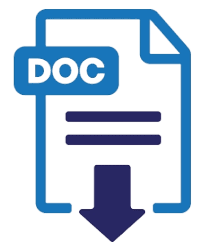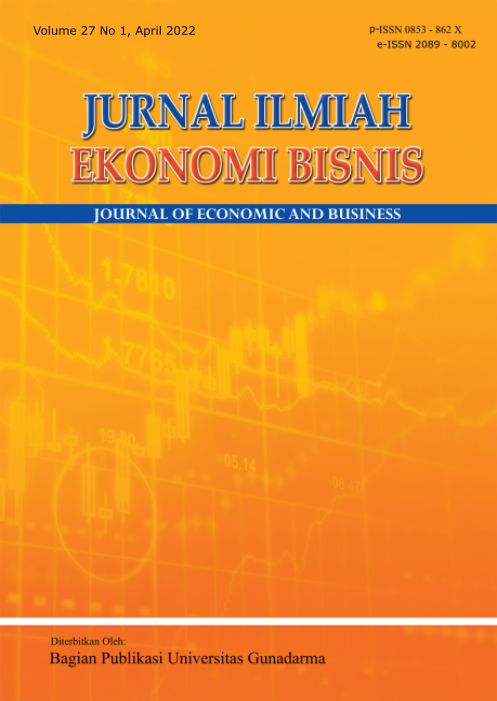INTELLECTUAL CAPITAL IMPACT ON TELECOMMUNICATION BUSINESS PERFORMANCE; IS IT REALLY MATTER?
Abstract
This study aims to determine the effect of IC represented by Value Added Intellectual Capital (VAIC) on Telco business performance from inside and outside perspective. We use ROE to represent inside perspective and MVA per Share to represent outside perspective on business performance. The sample consist of Telco listed on Indonesia Stock Exchange and we used period of 2011 - 2018. This study conducts simple panel data regression statistic. The result showed that IC give significant impact on both on inside and outside business performance perspective.
Keyword: Intellectual Capital, ROE, MVA Per Share
Keywords
References
Amit, R., & Schoemaker, P., (1993). Strategic assets and organizational rents.
Strategic management Journal, 14(1), 33–47.
Barney, J., (1991). Firm resources and sustained competitive advantage. Journal
of management, 17(1), 99–120.
Birdieani, B. (2018). Prioritaskan pengembangan digital talent & innovation, Telkom dorong terwujudnya Indonesia digital economy 2025. Retrieved from https://www.gatra.com/detail/news/350811-Prioritaskan-Pengembangan-Digital-Talent-Innovation-Telkom-Dorong-Terwujudnya-Indonesia-Digital-Economy-2025
Bontis, N. (1999) Managing an organizational learning system by aligning stocks of knowledge. (Doctoral’s dissertation). Faculty of Graduate Studies, Richard lvey School of Business. University of Western Ontario, Ontario, Canada.
Bontis, N. (2004). National intellectual capital index: A United Nations initiative for the Arab region. Journal of Intellectual Capital, 5(1), 13–39.
Castro, G. M. & Verde, M. D. (2012). Assessing knowledge assets in technology-intensive firms: proposing a model of intellectual capital. Journal of CENTRUM Cathedra, 5(1), 43–59.
Djamil, A. B., Razafindrambinina, D., & Tandeans, C. (2013). The impact of intellectual capital on a firm’s stock return: evidence from Indonesia. Journal of Business Studies Quarterly, 5(2), 176-183.
El‐Bannany, M. (2008). A study of determinants of intellectual capital performance in banks: the UK case. Journal of intellectual capital, 9(3), 487-498.
Gabriela, H. M., Dorinela, N. & Alexandra, I. (2012). Learning organization: the importance of innovation and adaptation. Ovidius University Annals, Economic Sciences Series, 12(2), 145–150.
Galbreath. J., (2005). Which resource matter the most to firm success? An
exploratory study of resource-based theory. Technovation, 25(9), 979-987.
Garcia-Meca, E. & Martinez, I. (2005). Assessing the quality of disclosure on intangibles in the spanish capital market. European Business Review, 17(4), 305–313.
Global Business Guide Indonesia. (2015). Indonesian Telecommunications an Increasingly Mobile. Market. Retrieved from http://www.gbgindonesia.com/en/services/article/2015/indonesian_telecomunications_an_increasingly_mobile_market_11108.php
Grant, R.M., (1991). The resource-based theory of competitive advantage:
implications for strategy formulation. California Management Review, 33(3),
–135.
Gujarati, D. N., & Porter, D. C. (2009). Basic econometric. McGraw Hill, New York.
Hall, R. (1992). The strategic analysis of intangible resources. Strategic Management Journal, 13(2), 135-144.
Herman, A. (2010). Intellectual capital and its measurements. Economics & Business
Administration Journal, 2, 7–16.
Kalkan, A., Bozkurt, Ö. Ç., & Arman, M. (2014). The impacts of intellectual capital,
innovation and organizational strategy on firm performance. Procedia-Social
and Behavioral Sciences, 150 (2014), 700-707.
Kartika, M., (2013). Pengaruh intellectual capital pada profitabilitas perusahaan perbankan yang terdaftar di Bursa Efek Indonesia pada tahun 2007-2011. Business Accounting Review, 1(2), 14-25.
Lev, B. (2007). Intangible Management, Measurement and Reporting. Brookings Institution Press: Washington D.C. Retrieved from: http://www.brookings.edu/press.
Maditinos, D., Chatzoudes, D., Tsairidis, C., & Theriou,G., (2011). The impact of intellectual capital on firms’ market value and financial performance. Journal of Intellectual Capital, 12(1), 132-151.
MacDougall, S. L., & Hurst, D. (2005). Identifying tangible costs, benefits and risks of an investment in intellectual capital: contracting contingent knowledge workers. Journal of Intellectual Capital, 6(1), 53–71.
Manzari, M., Kazemi, M., Nazemi, S. & Pooya, A. (2012). Intellectual capital: Concepts, components, and indicators: A literature review. Management Science Letters, 2(7), 2255–2270.
Marr, B. & Chatzkel, J. (2004). Guest editorial: Intellectual capital at the crossroads: Managing, measuring, and reporting of IC. Journal of Intellectual Capital, 5(2), 224–229.
Marr, B. & Moustaghfir, K. (2005). Defining intellectual capital: A three-dimensional approach. Management Decision, 43(9), 1114–1128.
Mondal, A., & Ghosh, S.K. (2012). Intellectual capital and financial performance of Indian banks. Journal of Intellectual Capital, 13(4), 515-530.
Pitkanen, A. (2006). The importance of intellectual capital for organizational performance. (Doctoral thesis). Turku School of Economics and Business Administration. Department of Accounting and Finance, Turku School, Turkey.
Pullic, A. (1998). Measuring the performance of intellectual potential in knowledge economy. Presented in 1998 at The 2nd McMaster World Congress on Measuring and Managing Intellectual Capital by The Austrian Team for Intellectual Potentia, 1–20.
Pradono, N. S. H. (2019). The rise of tower provider (what factors impact company’s performance?). KINERJA, 23(2), 132-142.
Pradono, N. S. H. & Widowati, E. H. (2016). Pengaruh komisaris asing, direktur asing dan kepemilikan asing terhadap kinerja intellectual capital. KINERJA, 20(2), 132-148.
Pratiwi, T.A., Yusnaini, & Ermadiani. (2018). Pengaruh pengungkapan intellectual capital terhadap kinerja perusahaan telekomunikasi yang terdaftar di Bursa Efek Indonesia. Jurnal Penelitian dan Pengembangan Akuntansi, 12(1) 57-68.
Roberts, P.W., & Dowling, G. R., (2002). Corporate reputation and sustained
superior financial performance. Strategic Management Journal, 23(12), 1077–
Roos, G. & Roos, J. (1997). Measuring your company’s intellectual performance. Long Range Planning, 30(3), 413–426.
Saleh, M. N., Rahman, C. A., & Ridhuan, M. (2009). Ownership structure and intellectual capital performance in Malaysia. Asian Academy of Management Journal of Accounting and Finance, 5(1), 1-29.
Sharabati, A., Jawad, S., & Bontis, N. (2010). Intellectual capital and business performance in the pharmaceutical sector of Jordan. Management Decision, 48(1), 105–131.
Sharabati, A. A., Shamari, N. S., Nour, A. I., Durra, A. I., & Moghrabi, K.M. (2016). The impact of intellectual capital on business performance in Kuwaiti telecommunication industry. International Journal of Business Performance Management, 17(4), 428- 446.
Shih. K. H., Chang, C. J., & Lin, B., (2010). Assessing knowledge creation and intellectual capital in banking industry. Journal of Intellectual Capital, 11(1), 74-89.



